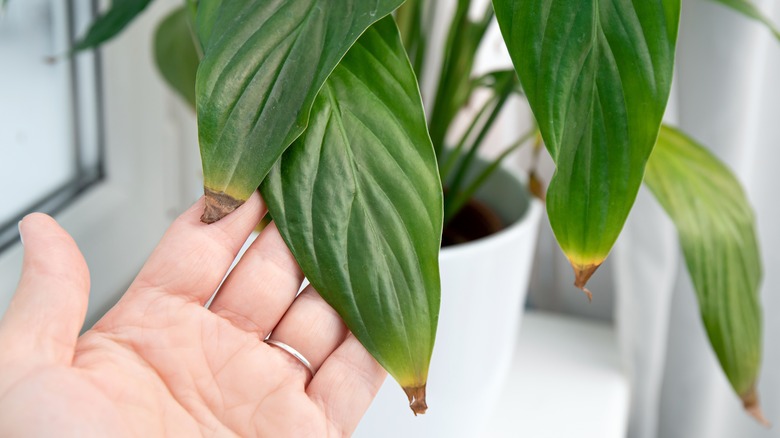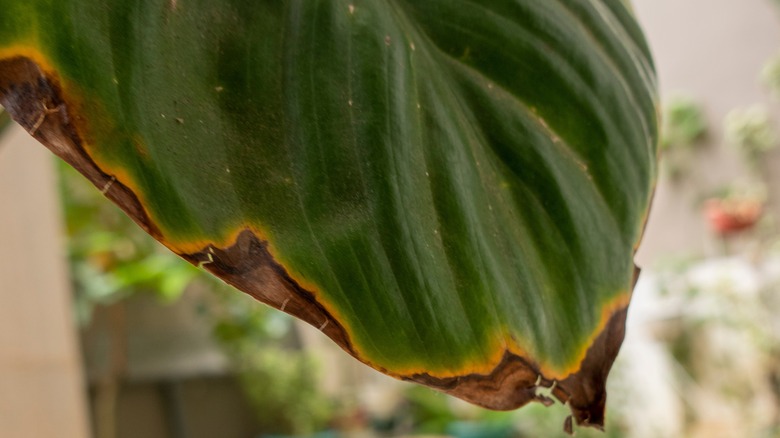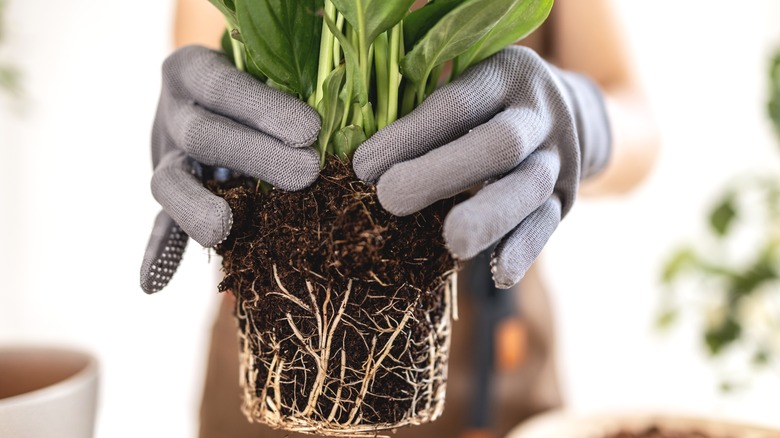The Big Mistake That's Causing Your Peace Lily's Leaves To Turn Brown
The soft white petals and the dark green foliage of the peace lily (Spathiphyllum) make it a gorgeous plant to place in your home. With long-lasting blooms from late spring through summer with proper care, this is an excellent choice for those who want a soft elegance to their living space. Yet, there are times when the leaves may begin to brown, and when that happens, it's time to take action to prevent any further risk to the plant's overall health. Several potential problems can cause browning of the lily's leaves – though one of the most common causes is simply putting too much fertilizer in their soil.
All plants need nutrients, but too much fertilizer can make it challenging for the roots to absorb enough water to keep the leaves properly hydrated. This doesn't happen with all fertilizers, so it's necessary to ensure the soil quality for your peace lilies is properly balanced to encourage growth. Before you start adjusting the peace lily's soil content, ensure other factors are not contributing to the browning. For example, these plants need ample humidity and consistency with temperature regulation. If they are in the hot sun for a long period, that, too, can cause the leaves to wilt and become damaged. If you've ruled out these concerns, take a closer look at the nutrient needs and the potential of over-fertilizing.
Why over-fertilizing is causing damage to your peace lily
The peace lily does best in USDA plant hardiness zones 11a to 12b or indoors in a temperature-controlled environment. It also needs proper soil quality to thrive, often doing best with soil high in organic matter. It's not uncommon for these plants to have a nitrogen deficiency, which often leads to a yellowing of the leaves, but browning is typically due to too much sodium. Many fertilizers have a high sodium level — the problem with this for peace lilies is that the sodium damages the roots' ability to draw in water.
Excess salt in the fertilizer remains in the soil, building up over time. The more sodium present, the harder it is for the plant's roots to function properly. Because the roots cannot absorb water, not enough moisture gets to the leaves, causing them to dry out and wither — the brown color is a sign of a plant that has significantly dried out like this. Sometimes, your plant may begin to show signs of browning but will continue to grow very slowly, struggling with recovery as well. That's likely to mean the sodium level in the plant's soil is high but not excessively high. Still, now is the best time to take action to protect your plants from further damage. Depending on the severity of the problem and how long it's lasted, you may be able to reverse the damage.
How to fix browning leaves on your peace lily
When there is damage to the peace lily's leaves, and you've ruled out other possible factors, then it's time to try to fix the soil. The best way to do this is to flush the soil to reduce some of the sodium (and other fertilizers) present. It's also a good idea to stop fertilizing the plant as often, instead, when you need to fertilize, try to use organic material that has a better blend of nutrients.
One way to do this is to simply replace all of the soil present. Remove the plant from the pot it's in and repot it in new soil that's better balanced. This will give the roots the ability to recover and begin absorbing water again. To do this, hold the plant at the stem, lift upwards gently to remove the root ball, and gently use your hand to loosen the soil. Place in a new planter with fresh soil and water. Because these plants are light-sensitive, put them in the shade for several days to give them a chance to recover. You will need to fertilize again over time, but when you do, use a half-strength product less often, even as little as once every two or so months. That is going to help with reducing the amount of salt that builds up in the actual soil, allowing the roots to continue to thrive.


